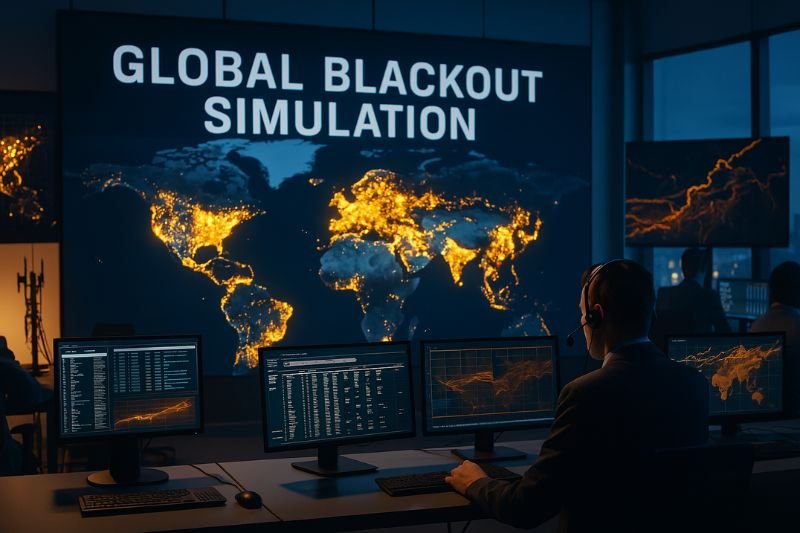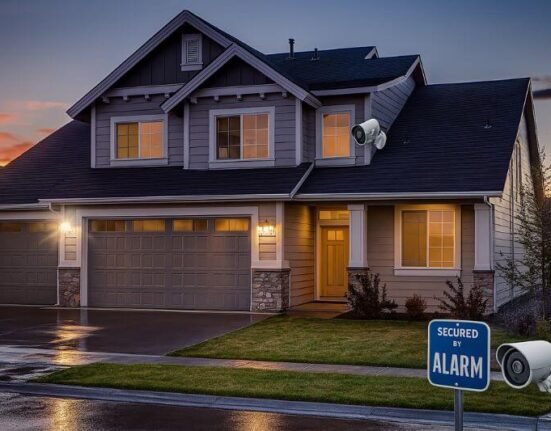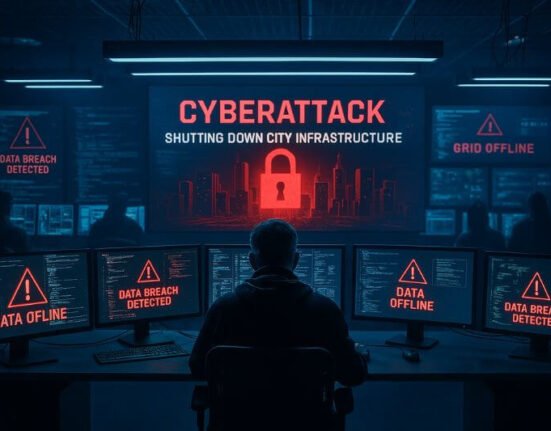What Happens When the Lights Go Out—for Good?
A global blackout simulation reveals what could happen if the world’s power grid failed overnight. Imagine waking up to a silent world: no phones, no internet, no electricity—and no answers.
This isn’t science fiction. It’s a scenario that emergency planners, cyber defense analysts, and survivalists are increasingly simulating: a global blackout caused by a massive power grid failure.
In an age of technological interdependence, the consequences of a long-term blackout would be catastrophic. From energy and food systems to communication, healthcare, and security, a collapse of the power grid would cascade through every layer of modern life.
In this article, we walk through a realistic global blackout simulation, explore the causes, timelines, survival challenges, and how you can prepare now. With “global blackout simulation” as our focus keyword, we’ll keep this both SEO-optimized and survival-practical.
What Could Trigger a Global Blackout?
While localized blackouts happen often, a truly global or continental-scale grid failure would require one of the following:
1. Massive Solar Flare (Carrington-Scale Event)
A supercharged coronal mass ejection (CME) from the sun could fry transformers, satellites, and high-voltage lines. In 1859, such an event (the Carrington Event) disrupted telegraph systems worldwide. If it happened today, it could knock out the entire global grid for months.
2. Coordinated Cyberattack on Critical Infrastructure
In 2023, the FBI and CISA reported multiple attempts by state-sponsored hackers to breach North American grid control systems. A coordinated cyberattack on SCADA systems (which control energy grids) could shut down major regions in hours.
3. Electromagnetic Pulse (EMP)
A high-altitude nuclear EMP detonation could disable unshielded electronics over vast areas. This has long been considered in military strategic planning, especially in conflict scenarios involving rogue states.
4. Cascading Infrastructure Failure
Power grids are interconnected ecosystems. A transformer failure in one country can trip circuits in others, causing ripple effects. In 2003, a tree touching a line in Ohio triggered a blackout affecting 55 million people.
Now imagine that—worldwide.
Phase 1 – The First 24 Hours
Most people won’t panic. Yet.
Phones might work for a few hours, cars still run, and city water systems function on backup generators. But news is missing. Internet is down. Traffic lights fail.
Within 12 hours:
- ATM machines stop working
- Grocery stores can’t accept card payments
- Hospitals run on limited backup power
Authorities may release vague statements: “a temporary outage,” “technical disruption.” But nothing comes back online.
Survivalists know what this means: the clock is ticking.
Phase 2 – Days 2 to 7: Collapse Begins
Fuel Shortages
Gasoline pumps run on electricity. Without grid power, fuel logistics stop. Long lines form at stations with diesel generators. Most go dry within 3 days.
Transportation halts. Trucks stop delivering food, medicine, and essentials.
Water and Sanitation
Municipal water pressure drops. Toilets stop flushing. People resort to collecting rainwater or breaking into pools. Sanitation systems fail.
Food Panic
Supermarkets without power can’t refrigerate or restock. Within 72 hours, most food is gone—hoarded or looted.
In urban areas, this is the tipping point.
Phase 3 – Weeks 2 to 4: Anarchy or Adaptation
Government Response Falters
Without electricity, communications between agencies collapse. Military may be deployed in urban zones, but fuel shortages hinder mobility. Martial law could be declared.
But without information, fear spreads faster than facts.
Medical Systems Collapse
Without refrigeration, insulin, vaccines, and antibiotics expire. Surgical procedures are impossible. Dialysis and ventilator patients die within days.
Hospitals become triage centers, not places of healing.
Crime and Violence
Without digital surveillance, alarms, or lighting, crime spikes. Looting, robbery, and armed raids become daily occurrences in cities. Gangs form rapidly where law enforcement withdraws.
People in rural areas begin organizing mutual defense groups. Firearms become essential—not optional.
Phase 4 – Month 2 and Beyond: Primitive Modernity
By now, only those who prepared are functional. Life resembles a low-tech survival state.
- Communication via CB/HAM radios
- Water from wells, rivers, or rooftop collection
- Gardens and livestock replace supermarkets
- Trade resumes in the form of barter and silver coins
Those with off-grid setups—solar panels, inverters, protected battery banks—gain major leverage.
Cities become inhospitable. Bugging out to rural safe zones is now a matter of life or death.
How Long Would It Last?
A global blackout could last:
- 1–3 weeks if cyberattack damage is limited and systems are backed up
- 3–6 months for EMP events or major CMEs, due to burned transformers (which take time to manufacture)
- 1 year or more if multiple continents are affected and supply chains for replacement parts are down
Most nations have no large-scale grid repair protocol for such events. The complexity of modern infrastructure makes rapid recovery unlikely.
Survival Planning for a Global Blackout Scenario
1. Power Independence
Invest in solar panels with EMP-protected inverters, and battery banks stored in Faraday cages.
Use DC-powered essentials like LED lighting, water pumps, and fans. Avoid relying on grid-tied inverters (they go offline with the grid).
Keep hand-crank tools and a solar oven or rocket stove.
2. Water Security
Install a gravity-fed rainwater system with pre-filtering and UV purification.
Stock at least 100 liters per person, and rotate regularly. Learn how to dig a shallow well or purify creek/river water.
3. Food Systems
Maintain a 1-year pantry:
- Grains (rice, oats, pasta)
- Canned goods (meat, beans, vegetables)
- Dehydrated meals and MREs
- Seeds for planting high-calorie crops (potatoes, squash, corn)
Include manual kitchen tools: can opener, grain mill, food dehydrator (solar-powered if possible).
4. Security Measures
Install motion sensor lights powered by solar, perimeter alarms, and train with defensive tools (firearms, bows, slingshots).
Fortify doors and windows. Practice night movement drills and home defense protocols.
Know your neighbors—create defense pacts or mutual aid groups before collapse.
5. Communications
Use shortwave (HAM) radios and walkie-talkies with rechargeable batteries.
Store news sources (USB, SD cards) with offline guides on:
- Medical care
- Mechanical repair
- Foraging
- Survival psychology
Build a communications SOP (standard operating procedure) for your group.
6. Community Structure
Form a micro-village network with:
- Roles (medic, cook, scout, mechanic)
- Barter systems
- Rules of conduct
- Daily schedules (guard duty, cooking, farming)
Trust and discipline become more valuable than any stored item.
Global Blackout Simulation vs Reality: Are We Truly Prepared?
Governments conduct blackout simulations regularly:
- North American Electric Reliability Corp (NERC) runs “GridEx” exercises
- The UK’s “Dark Sky” scenario imagines a 30-day power loss
- The EU’s “CyberPoligon” event explores digital collapse
But the public? Largely unprepared.
Most homes have less than 3 days of food. Less than 20% own generators. Fewer have any real blackout survival plan at all.
If the grid went down tomorrow, millions would die—not because of the event itself, but because of dependence on fragile systems.
When the Lights Go Out, Who Survives?
A global blackout simulation reveals more than technical vulnerabilities. It shows us how deeply civilization depends on power, data, and logistics.
For survivalists, this is not fearmongering—it’s foresight.
Whether triggered by a solar flare, EMP, or cyberattack, the consequences of a total grid failure are unimaginably severe. But with knowledge, preparation, and resilience, survival is not only possible—it can be sustainable.
Because when the lights go out… those who prepared won’t panic—they’ll adapt.















